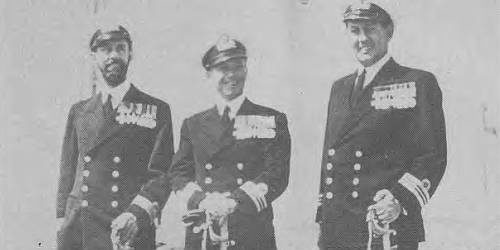- Author
- Goldsworthy, Lieutenant Commander L V GC DSC GM RANVR
- Subjects
- History - general
- Tags
-
- RAN Ships
- None noted.
- Publication
- January 1972 edition of the Naval Historical Review (all rights reserved)
About the Author: Lieutenant Commander Leon Verdi Goldsworthy was born in Broken Hill, NSW, in 1909. Mobilised as a Sub-Lieutenant on Probation in 1941, he proceeded to England, there to begin a long career of mine disposal. He was awarded the George Medal in April 1944 and the George Cross in September 1944. In January 1945 he received the DSC for stripping the first German ‘K’ mine. Lieutenant Commander Goldsworthy now lives in Perth.
MINES ARE INTERNATIONAL and of many kinds. In this article they are German moored and influence mines used by the Germans in the 1939-45 War. By definition a mine is any quantity of explosive which may be detonated by a time device, a chemico/mechanical or chemico/electrical device, a chemical etch, electrolite, magnetic forces, acoustics or combinations of these two and pressure. These were the weapons against which a small group of specialists were to pit their brains, training, experience and lives from the first days of the war.
The war was only weeks old when it was realised that ships were being sunk by other than conventional moored mines. The Orepesa minesweepers detailed to sweep the mines had as little immunity as other vessels.
The brilliant recovery of two unexploded magnetic mines at Bhaeburyness in November 1939 provided grim proof to the Enemy Mining Section of HMS Vernon of the war it was to fight. From that time forward a macabre competition developed between German inventors and individual members of EMS. It was a fierce and unyielding competition.
So confident did the Germans become that two special mines were laid near the quarries used by the Enemy Mining Section for the final breakdown of ‘captured objects.’
As the war progressed, so did the frightfulness of the weapons employed. ‘Self destroy’ mines and acoustic mines sent British shipping losses upward. While EMS was attempting to grapple with the problem of these new weapons, Hitler launched his blitzkrieg on the cities of England.
The first of the blitz weapons was the parachute mine. The section, which up to then had worked at sea or close to the sea, soon found itself working in the cities selected as the Germans’ target.
Night after frightful night his bombers dropped incendiary and high explosive bombs and parachute mines on London and its docks, on other ports and cities.
In the long term the German switch from the sea to the land was a mistake. The armourers were diverted from the magnetic and acoustic mines, which were still mystery weapons, to the conventional bombs and mines. As the tempo of the raids increased, mines were dropped on land with the magnetic and acoustic units still fitted. The recovery of some of these latter mines provided bodies for examination.
The task imposed on EMS soon outstripped its capacity and very soon a larger unit, the Rendering Mines Safe Section, was hastily formed. It was based on Admiralty in London and after only minimal training was set to work. Their orders were simple and to the point: ‘get rid of the damned things.‘
This the section proceeded to do – in the streets and in the warehouses, in theatres, in the quiet of the countryside, in the stinking bowels of a gasometer, welded to the electrified rails of a suburban railway, mushroomed into the concrete railway over a tube station, in pubs and private gardens, and even within range of No. 10 Downing Street. The famous ‘Ronnie Smith’ mine flaunted its evilness behind the altar of St. Paul’s. Many lay buried and inaccessible.
The section comprised Wadsley, Syme, Mould, Gidden, Armitage, Newgas, Fenwick, Smith, Taylor, Kessack, Reid, Cliff, Upton, Gosse, Goldsworthy and others.

L to R: Lieutenant Commander G Gosse, G.C., RANVR, Lieutenant Commander LV Goldsworthy G.C., D.S.C., G.M. RANVR, Lieutenant Commander J.S. Mould, G.C., G.M, RANVR.
They were accommodated in a single room in Banks Block at Admiralty and this became the cradle, haven, school and workshop of a band of warriors who cringed and worried all night during the raids but sallied forth at first light to delouse or destroy – to be lucky or be destroyed.




